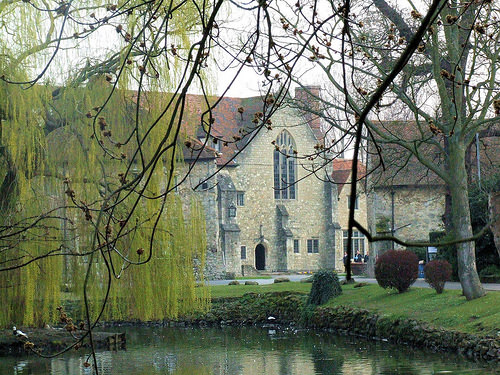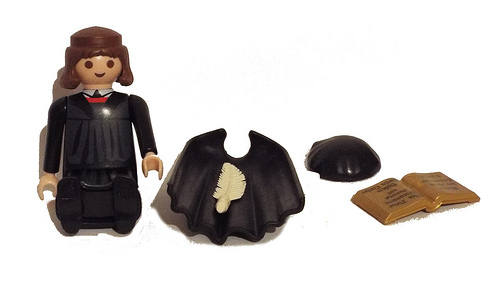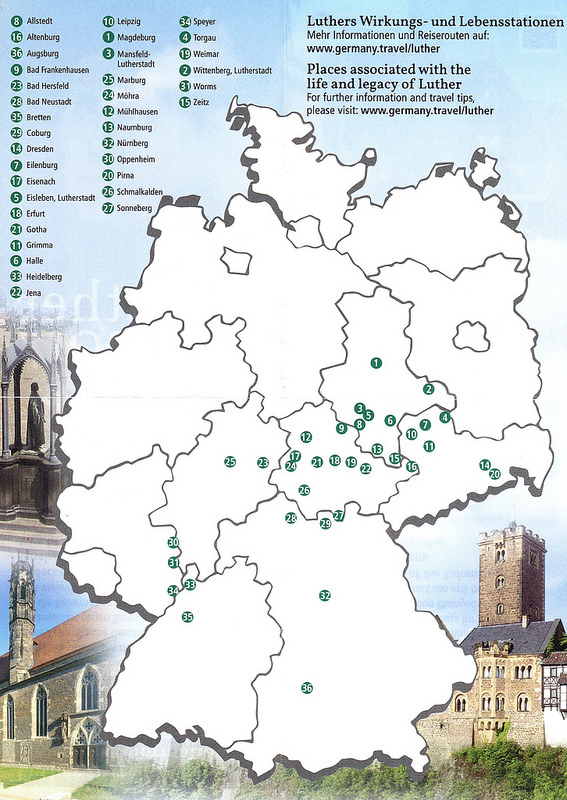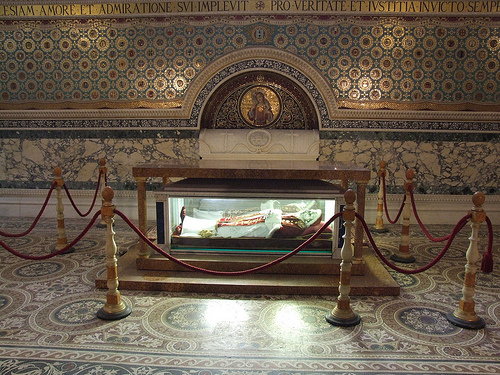The hermeneutic of continuity
Therefore every scribe who has been trained for the kingdom of heaven is like a householder who brings out of his treasure what is new and what is old.
Saturday, 5 November 2016
Confraternity of Catholic Clergy Colloquium 2016
Aylesford Priory, the home of the brown scapular, recovered by the Carmelites 400 years after it was dissolved by King Henry VIII, was the venue for the 2016 colloquium of the British Province of the Confraternity of Catholic Clergy last week. About fifty of us gathered to hear a fine selection of speakers, celebrate the sacred Liturgy, and enjoy informal convivium.
Fr Jerome Bertram of the Oxford Oratory spoke on ‘Holy Orders: the Sacrament, Celibacy and the Vita Communis’, Dom Mark Kirby, Prior of Silverstream Monastery (and blogger at Vultus Christi), took the subject ‘Primary and Indispensable: the liturgy, Wellspring of Life’, and Fr Guy de Gaynesford, Rector of the School of the Annunciation which is based at Buckfast Abbey, spoke on ‘New Evangelisation and the Pedagogy of God’. The Mass on Thursday was celebrated by Bishop Paul Mason, Auxiliary in Southwark, who has pastoral responsibility for Kent, and on Friday, the celebrant was Mgr Newton, the Ordinary of the Ordinariate of Our Lady of Walsingham.
During these events, I always enjoy the opportunity over meals or at the convivium to catch up with old friends and meet fellow clergy engaged in a variety of apostolates. Among many others, fellow blogger Fr Ed Tomlinson was on good form, and Fr de Malleray had encouraging news of the continuing health of the FSSP in the UK.
Saturday, 29 October 2016
Belfast bakery ruling and the feast of Christ the King
In the traditional liturgical calendar, tomorrow is the feast of Christ the King. Preparing for it it, and specifically re-reading the encyclical Quas Primas of Pope Pius XI, put me in mind of the appalling decision of the court of appeal in Belfast in the case of the Ashers Baking Company. I found the above video on various news websites, then tracked it down on YouTube for embedding here. Daniel McArthur gives a fine speech which is moderate, sensible and balanced. At the end he gives powerful witness to his faith, thanking God for His faithfulness. He concludes with vigour (2'04"):
"He is still on the throne, He is the ruler of heaven and of earth, and He is our God and we worship and we honour Him."Not a bad way to end a statement for the press, and an ecumenical inspiration on the eve of the feast of Christ the King. May God bless Daniel and his family! Viva Cristo Rey!
Tuesday, 25 October 2016
Rosary at sunset low tide and communicatio in sacris
One of the great things about living in Margate is being able to walk on the beach and say the Rosary when there is an evening low tide. If this coincides with sunset, so much the better. The above photo was taken in mid September when it was warm enough for people to mess around in the sea at that time of the evening.
We have now just passed a significant point of the year: the beach motocross weekend. This happens in spring and autumn and marks the change of seasons. The sand on the beach is shoved around by heavy machinery to make jumps and obstacles for the two-stroke motorbikes and the quad bikes that young lads race around for a couple of days. Then the beach is tidied up and a berm is built up in the autumn to act as a secondary defence against flood tides. In the spring it is bulldozed down for the bikes and the summer season.
Just by way of putting photos on the blog that I am pleased with, let me mention also that living in Margate means that it is only half an hour on the train for a day off in Canterbury. The photo below is of the Cathedral from the ruins of St Augustine's Abbey. (You don't need me to tell you who ruined it.) I usually bring the day off to a pleasant close with a little communicatio in sacris by attending Evensong at the Cathedral.
Monday, 24 October 2016
A made-up Luther
After the traditional Mass yesterday, some children from one of our families gave me an early Halloween present: the Playmobil model of Martin Luther. This is a best-seller, apparently, having been issued in advance of next year's celebrations of the 500th anniversary of Martin's publishing his 95 theses and starting the Reformation.
Here are the contents of the box:
There is a rich learning opportunity here. The cloak could stand for the cloak of righteousness as in imputed justification: it clips on externally without changing Martin interiorly. You could discuss whether Martin should take off the clerical hat when he decides that the priesthood of the baptised is not distinct from the ministerial priesthood, or indeed whether the hat can be put on any other Playmobil figure that has been baptised. Then the scriptures could be taken away from Martin and made to stand on their own. Hours of fun.
Here's Martin made up with all his props:
Included in the box is a helpful map of places associated with Martin's life and legacy so that you can arrange a pilgrimage.
As far as I know, you can't get an indulgence for a pilgrimage to the holy sites of Martin yet, but who knows what surprises might await us in the great centenary?
By way of broadening the historical perspective, I got out my model of Martin's friend, John.
Unfortunately, they had some misunderstandings over the Eucharist, the priesthood, justification, indulgences, relics and other technical questions, but we know, boys and girls, that there won't be any misunderstandings for either of them now!
Saturday, 22 October 2016
Byrd 3 at Margate for Christ the King
Next Sunday 30 October, at St Austin and St Gregory, Margate, we have a schola visiting to sing William Byrd's Mass for Three Voices at our 11.30am Missa Cantata. They will also sing Mariano Garau's O Bone Jesu, and Claudio Casciolini's Tantum Ergo. The group is led by Gregory Treloar, a music student at Canterbury Christ Church University. This is an opportunity for a group of young people to sing some beautiful sacred music in the liturgical setting for which it was composed, as well as for my parishioners to benefit from the same - and indeed our visitors.
Many thanks to the Latin Mass Society for a grant which has enabled us to plan this and a couple of other polyphonic Masses this year.
If you want some extra reasons to make a day trip to Margate next week, it is always worth seeing our lovely Church with its Edward Pugin Lady chapel. At the Turner Contemporary, there is currently a splendid exhibition of over 100 Turners on the theme of "Adventures in Colour." There are some excellent places for lunch, and a wealth of micropubs if you want to find good real ale. Naturally, after either, there is the possibility of a bracing walk on the beach (low tide will be at 6pm.) Margate is an hour and a half from St Pancras.
Friday, 21 October 2016
When England led the world in vestment making
 |
| The Butler-Bowdon Chasuble, 1398 – 1420 |
Yesterday I had intended to visit the British Library at St Pancras, but a friend at the Keys convinced me to take the Piccadilly line in the other direction to one of my favourite places, and view an exhibition which is on at the Victoria and Albert Museum until 5 February 2017: Opus Anglicanum: Masterpieces of English Medieval Embroidery.
Over 100 pieces are gathered for the exhibition, most of them ecclesiastical vestments. The earliest are from the early 12th century, but the period of greatest popularity represented is the first half of the 14th century. Thus the growth of world-renowned expertise and enthusiasm for fine liturgical decoration coincided with the flowering of scholastic culture at, for example, places like Oxford and Cambridge. The overturning of that culture at the English reformation coincided with the physical destruction of the beautiful work that grew alongside it. The exhibition has one or two pitiful examples of work that was preserved by virtue of being disguised for secular use.
The splendid collection includes a rare High Mass set and some interesting chasubles like the Butler-Bowden chasuble above. From a modern bias towards a binary distinction between Roman and Gothic chasubles, they might seem hybrid, but I suppose they were simply a stage in the developing shape.
It is great that the V&A has put on another exhibition which draws on Catholic culture in England, and that it seems to be attracting a healthy number of visitors. As a result of following the course carefully, I now know what underside couching is.
Image credit: Victoria & Albert Museum website
When England led the world in vestment making
 |
| The Butler-Bowdon Chasuble, 1398 – 1420 |
Yesterday I had intended to visit the British Library at St Pancras, but a friend at the Keys convinced me to take the Piccadilly line in the other direction to one of my favourite places, and view an exhibition which is on at the Victoria and Albert Museum until 5 February 2017: Opus Anglicanum: Masterpieces of English Medieval Embroidery.
Over 100 pieces are gathered for the exhibition, most of them ecclesiastical vestments. The earliest are from the early 12th century, but the period of greatest popularity represented is the first half of the 14th century. Thus the growth of world-renowned expertise and enthusiasm for fine liturgical decoration coincided with the flowering of scholastic culture at, for example, places like Oxford and Cambridge. The overturning of that culture at the English reformation coincided with the physical destruction of the beautiful work that grew alongside it. The exhibition has one or two pitiful examples of work that was preserved by virtue of being disguised for secular use.
The splendid collection includes a rare High Mass set and some interesting chasubles like the Butler-Bowden chasuble above. From a modern bias to distinguishing between Roman and Gothic chasubles, they might seem hybrid, but I suppose they were simply a stage in the developing shape.
It is great that the V&A has put on another exhibition which draws on Catholic culture in England, and that it seems to be attracting a healthy number of visitors. As a result of following the course carefully, I now know what underside couching is.
Image credit: Victoria & Albert Museum website
Thursday, 20 October 2016
Happy feast day to our friends in Chicago
After returning from an overnight stay in London for a meeting of the Keys, I celebrated a quiet Mass in honour of St John Cantius whose feast day it is today in the traditional calendar. A physicist as well as a theologian, he helped gave impetus to the theory of impetus, furthering the scholastic foundations of modern science. He is one of the Polish saints canonised after the Reformation who formed a significant part of the list of saints.
Among traditionalist bloggers, he is known particularly as the patron saint of the fine Church in Chicago where Holy Mass is offered in both the ordinary and extraordinary forms of the Roman Rite every day. Fr Frank Phillips, who became Pastor (Parish Priest) in 1988 began the work of physical restoration of the Church alongside the restoration of the liturgical life of the Church. He founded the Canons Regular of St John Cantius who continue with him to care for the parish today.
This video Saint John Cantius: Restoring the Sacred gives an idea of the amazing life of the parish.
It seemed like a good feast day to re-start the blog after a too-long hiatus. Happy feast day to my friends at St John Cantius!
Among traditionalist bloggers, he is known particularly as the patron saint of the fine Church in Chicago where Holy Mass is offered in both the ordinary and extraordinary forms of the Roman Rite every day. Fr Frank Phillips, who became Pastor (Parish Priest) in 1988 began the work of physical restoration of the Church alongside the restoration of the liturgical life of the Church. He founded the Canons Regular of St John Cantius who continue with him to care for the parish today.
This video Saint John Cantius: Restoring the Sacred gives an idea of the amazing life of the parish.
It seemed like a good feast day to re-start the blog after a too-long hiatus. Happy feast day to my friends at St John Cantius!
Sunday, 24 April 2016
Peter, teach us; confirm thy brethren
For my breakfast reading at the moment, I am enjoying Pius IX And His Time by the Rev Aeneas MacDowell Dawson which I obtained free of charge from Amazon. It is fascinating to discover the scope of the ministry of Blessed Pio Nono and his concern for the Church throughout the world at a time when his own liberty and life was threatened.
In the midst of great troubles, he consulted the bishops of the world on the advisability of defining doctrine of the immaculate conception of our Blessed Lady. He gathered in Rome the largest concourse of Bishops since the 4th Lateran Council in 1215. The question arose whether the bishops would assist him in coming to a decision and pronounce simultaneously with him, or leave the final judgement to him alone. MacDowell reports:
[...] the debate, as if by inspiration from on high, came suddenly to a close. It was the Angelus hour. The prelates had scarcely resumed their places after the short prayer, and exchanged a few words, when they made a unanimous declaration in favor of the supremacy of St. Peter's chair: Petre, doce nos; confirma fratres tuos - "Peter, teach us; confirm thy brethren."
Monday, 18 April 2016
Three cheers! A new lectionary in the pipeline - using the RSV
Ten years ago, I reported the news that Ignatius Press had produced a lectionary using the text of the Revised Standard Version 2nd Catholic edition and that it had been approved for use - in the Antilles. I suggested then, that "It would be a very good thing if this version were approved for use in England."
In November 2015, there was some good news on this front which went largely unnoticed. In the Plenary session of the Catholic Bishops of England and Wales, one of the short resolutions was:
Since there may be some questions regarding details, it would be well to clarify a few points.
For English Catholics, the change to using the RSV will be a vast improvement. We have been largely limited to the Jerusalem Bible version which is not a translation from the original texts but from a French translation. Worse than that, it is filled with laughable colloquialisms.
Off the top of my head, and therefore without references, but with a weary familiarity with an utterly undignified text, here are just a very few examples of what we may soon be able to say goodbye to:
In November 2015, there was some good news on this front which went largely unnoticed. In the Plenary session of the Catholic Bishops of England and Wales, one of the short resolutions was:
LectionaryI don't think there are any major changes to the 2010 version, so I presume (and hope) that the approval of the Holy See would not present any problems.
The Bishops’ Conference agrees to seek the approval of the Holy See for the use of the Revised Standard Version (2nd Catholic edition 2010) and the Revised Grail Psalter (2010) in the preparation of a Lectionary for use in England and Wales.
Since there may be some questions regarding details, it would be well to clarify a few points.
- The RSV Catholic edition of 1966 is still legitimate for use in England and Wales, though no new lectionaries using this version have been produced for many years.
- The 2006 (2nd Catholic edition) published by Ignatius, was brought into accord with Liturgiam Authenticam.
- The most noticeable change is the use of modern pronouns and verb forms. In the 1966, the form such as "Thou didst" were used in texts where God is addressed directly.
- Other changes relate particularly to favouring Catholic renderings of versions of disputed texts. The most famous of these is the translation "Behold a Virgin shall conceive and bear a son" (Is 7.14) rather than "young woman."
- The RSV is very different from the New Revised Standard Version. The NRSV was strongly committed to inclusive language (see this page for information) and was rejected for liturgical use by the Congregation for the Doctrine of the Faith.
For English Catholics, the change to using the RSV will be a vast improvement. We have been largely limited to the Jerusalem Bible version which is not a translation from the original texts but from a French translation. Worse than that, it is filled with laughable colloquialisms.
Off the top of my head, and therefore without references, but with a weary familiarity with an utterly undignified text, here are just a very few examples of what we may soon be able to say goodbye to:
"You make a fine king of Israel and no mistake!" [Jezebel to Ahab]It would be worth publicising your favourite silly verses from the current Jerusalem Bible lectionary, because as sure as night follows day, we can expect a whingeing sub-marxist campaign against this sensible and long overdue resolution of the Bishops. Be prepared to be told how you, the people, are being oppressed by the fancy words and non-inclusive language of the inspired scriptures translated with reasonable accuracy.
"Peter, who had practically nothing on ..."
"Simon, son of John, you are a happy man ..."
"and he began to feel the pinch" [the prodigal son]
"Leave off! That will do!" [Jesus in the garden of Gethsemane]
"You don't seem to have grasped the situation at all" [Caiaphas]
Subscribe to:
Posts (Atom)












